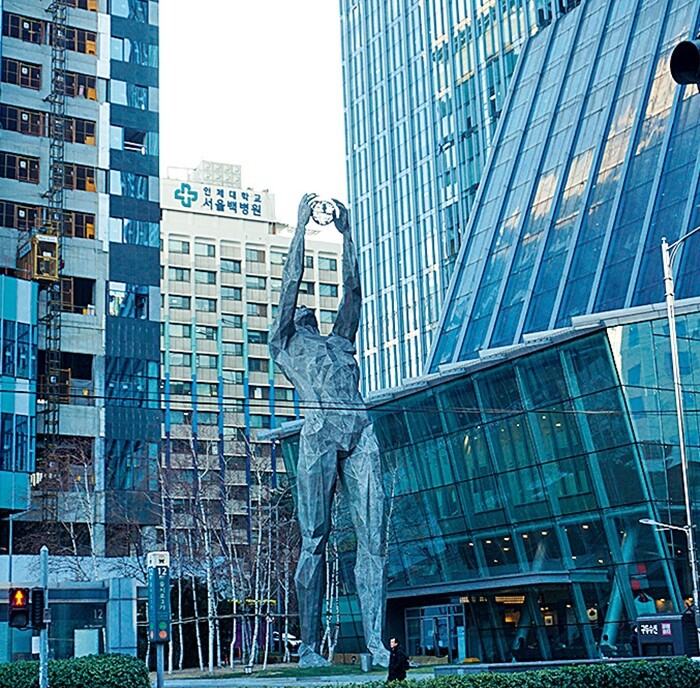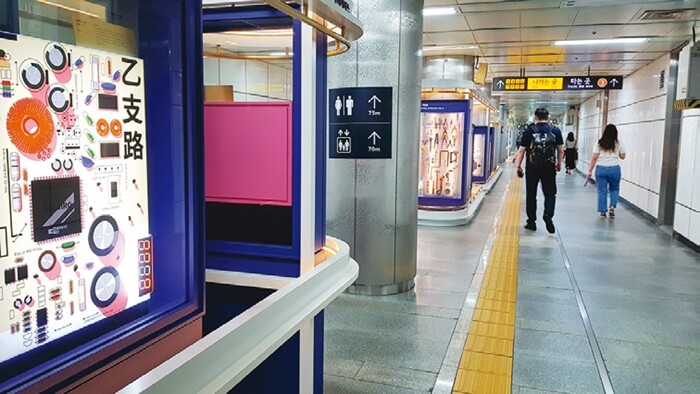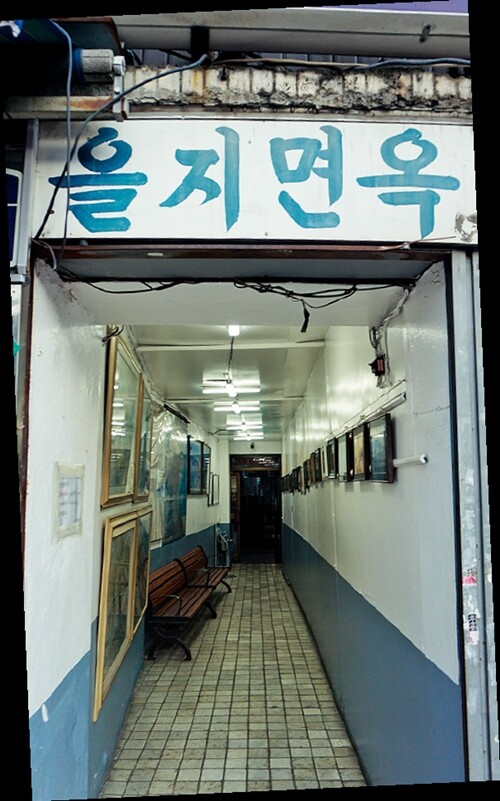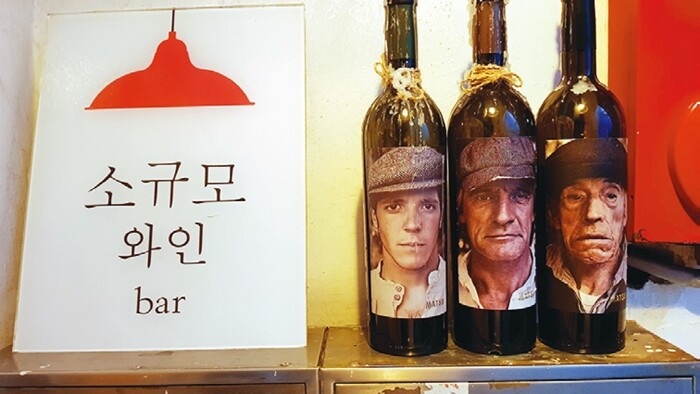hankyoreh
Links to other country sites 다른 나라 사이트 링크
[Seoul travels]Euljiro 3-ga: where new and old collide

Euljiro 3-ga is a neighborhood I remember via my taste buds. When my friends and I dropped by my father’s hole-in-the-wall tool store in Euljiro in high school, he took us out to a restaurant that served bulgogi and naengmyeon — grilled marinated beef and noodles swimming in a cold broth. We weren’t old enough to appreciate naengmyeon yet, so we wolfed down the bulgogi and bowls of rice.
I don’t remember the exact location of the restaurant where my father made such a good impression on my friends, or, for that matter, the location of his small shop. Even so, Euljiro 3-ga always reminds me of the sweet taste of bulgogi on the tip of my tongue.
Today, I’m older than my father was back then; in fact, he passed away many years ago. The neighborhood has gotten a complete makeover and is now known by the playful portmanteau “Hipjiro,” referring to the neighborhood’s originality.

To kick off my exploration of the area, I disembark from the Seoul metro at Euljiro 3-ga Station. I was planning to head out Exit 1, but then a glass display case in the underground walkway that said “made in Euljiro” catches my eye. The case is chock-full of tools — hammers, pliers, saws, drills, and the like — along with a sign that says, “a place that can make any tools.”
There are also displays with information about the neighborhood. A display called “creative activity fit for Euljiro” shares stories about artists who’ve recently set up workshops in the neighborhood. Some of the advantages for artists are the affordable prices and the ability to get any technical work handled in the area. Here are some comments from an art director and a graphic designer:
“Euljiro 3-ga is the ideal place if you know how to take advantage of the technicians and materials at Bangsan Market, the light fixture street nearby, the print shops at Chungmuro, and the lumber street at Euljiro 5-ga.”
“Since this is where subway Lines 2 and 3 intersect, it’s good for setting up meetings with clients. The downside is that the dust from the metalworking shops and the chemical smell of screen printing and acrylic plastics can feel a little intense sometimes.”

Sure enough, this is a neighborhood where opposites collide. It’s the intersection of the old and new, boomers and zoomers, the tang of naengmyeon and the whiff of chemicals. The back streets of Euljiro bring together the brilliant ideas of independent artists with the time-tested craftsmanship of career machinists.
I walk through an underground marketplace complete with a tarot card reader, a business card vendor, a sock vendor (“seven pairs for 5,000 won, or US$4.31”), and a lottery ticket store and come out Exit 1. Crossing Euljiro Street, I notice a hulking statue called “Atlas” in front of the Pine Avenue building. The statue is a new landmark, dividing the neighborhood’s past from its present.
Toward Euljiro 1-ga, there’s a cluster of big office towers and financial institutions, while the area around Euljiro 3-ga used to be dominated by small businesses and traditional alleys. But the landscape of the neighborhood has changed over the past few years, as young people have gravitated here to set up workshops in the back alleys. Just a few steps from the “Atlas” statue, in the direction of Paik Hospital, I come upon a handful of alleys dotted with small print shops; at night, the alleys’ snail restaurants are a big draw.
Turning my eyes back toward Exit 1, I see quite a few shops selling lighting fixtures and building materials such as tiles and ceramics. There’s also a branch of the Subway sandwich chain next to the subway exit. Whereas older folks prefer a cheap and simple meal of rice, soup, and side dishes, Subway is a favorite among younger people who have been setting up workshops in the area. This is evidence that dining options in Euljiro — though still catering to middle-aged men — are slowly but surely adjusting to a younger market.

There are stark differences between Euljiro by day and by night. After sundown, Euljiro Nogari Alley — named for young pollack, a popular beer munchie — is a magnificent sight to behold. In the alleys near Staz Hotel, between Exits 2 and 3 of the nearest subway station, visitors will find pubs such as Manseon Hof, Original Manseon Hof, and Uljiro OB Bear (sic) and loads of office workers sitting outside, enjoying a glass of beer and a bite of dried pollack, along with the crisp night air. The neighborhood has been hit hard by COVID-19, but the energy will return once the pandemic has passed.
From here, I cross over to Exit 5 of the station to find Eulji Myeonok, a well-known naengmyeon joint. The newspapers say the area will be bulldozed for a redevelopment project, while a banner hanging up nearby declares staunch opposition to the project. Amid the chaos, Eulji Myeonok is still serving up bowls of naengmyeon.
The entrance is adorned with newspapers I’ve never heard of before, such as the Five Provinces Newspaper and the Yellow Sea Daily. Euljiro and Chungmuro have long been known for their naengmyeon. With Eulji Myeonok at Euljiro 3-ga, Uraeok at Euljiro 4-ga, Pildong Myeon-ok at Chungmuro Station, and Hamheung naengmyeon street in the Ojang neighborhood, smack dab in the middle, this is an area that tickles the taste buds.

Exiting Eulji Myeonok, I follow Chungmuro Street to Chungmuro 7-gil, behind Exit 10 of the subway station, where a different landscape unfolds. Tucked in beside the print shops and acrylic name plate stores is Le Temple, a wine bar with a unique vibe that has been riding a wave of popularity. A little further toward Exit 9 is the curiously named Small-Scale Wine Bar, on the second floor of a dilapidated building. This alley has also fallen on hard times during the pandemic.
In the back streets of Euljiro, it’s not easy to find a destination, even with a map. The warren of alleys contains a jumble of aging buildings, and many of the establishments don’t even have a sign. But perhaps that charm is the very reason why Euljiro has come to be known as “Hipjiro.” Hunting down these places with smartphone in hand has become a kind of game for young people.
Night has fallen, but one of the stores is still open. Out front, a middle-aged man exhales, unfurling a ribbon of tobacco smoke. His face bears witness to worries about how to make a living when the pandemic has cut into his business. His feelings are probably shared by most fathers in the world today. Amid the tobacco smoke, I fancy I can see my own father, who was also a heavy smoker. My father’s face is full of the anxiety, discouragement, and helplessness that he felt after his business went under. In another moment, my father vanishes, along with the smoke, into the air.
By Son Kwan-seung, travel writer
Please direct comments or questions to [english@hani.co.kr]
Editorial・opinion
![[Editorial] Penalties for airing allegations against Korea’s first lady endanger free press [Editorial] Penalties for airing allegations against Korea’s first lady endanger free press](https://flexible.img.hani.co.kr/flexible/normal/500/300/imgdb/original/2024/0502/1817146398095106.jpg) [Editorial] Penalties for airing allegations against Korea’s first lady endanger free press
[Editorial] Penalties for airing allegations against Korea’s first lady endanger free press![[Editorial] Yoon must halt procurement of SM-3 interceptor missiles [Editorial] Yoon must halt procurement of SM-3 interceptor missiles](https://flexible.img.hani.co.kr/flexible/normal/500/300/imgdb/child/2024/0501/17145495551605_1717145495195344.jpg) [Editorial] Yoon must halt procurement of SM-3 interceptor missiles
[Editorial] Yoon must halt procurement of SM-3 interceptor missiles- [Guest essay] Maybe Korea’s rapid population decline is an opportunity, not a crisis
- [Column] Can Yoon steer diplomacy with Russia, China back on track?
- [Column] Season 2 of special prosecutor probe may be coming to Korea soon
- [Column] Park Geun-hye déjà vu in Yoon Suk-yeol
- [Editorial] New weight of N. Korea’s nuclear threats makes dialogue all the more urgent
- [Guest essay] The real reason Korea’s new right wants to dub Rhee a founding father
- [Column] ‘Choson’: Is it time we start referring to N. Korea in its own terms?
- [Editorial] Japan’s rewriting of history with Korea has gone too far
Most viewed articles
- 160% of young Koreans see no need to have kids after marriage
- 2Presidential office warns of veto in response to opposition passing special counsel probe act
- 3Months and months of overdue wages are pushing migrant workers in Korea into debt
- 4Hybe-Ador dispute shines light on pervasive issues behind K-pop’s tidy facade
- 5Japan says it’s not pressuring Naver to sell Line, but Korean insiders say otherwise
- 6[Reporter’s notebook] In Min’s world, she’s the artist — and NewJeans is her art
- 7[Editorial] Penalties for airing allegations against Korea’s first lady endanger free press
- 8Inside the law for a special counsel probe over a Korean Marine’s death
- 9OECD upgrades Korea’s growth forecast from 2.2% to 2.6%
- 10[Exclusive] Hanshin University deported 22 Uzbeks in manner that felt like abduction, students say